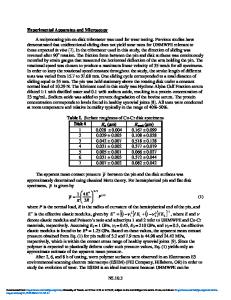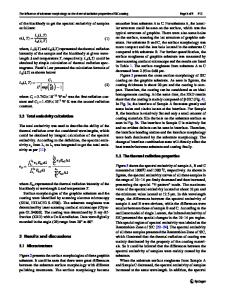Influence of substrate roughness on the adhesion and tribological performance of Titanium Nitride coating on AISI H13 st
- PDF / 1,268,999 Bytes
- 6 Pages / 432 x 648 pts Page_size
- 86 Downloads / 351 Views
MRS Advances © 2018 Materials Research Society DOI: 10.1557/adv.2018.591
Influence of substrate roughness on the adhesion and tribological performance of Titanium Nitride coating on AISI H13 steel Ricardo Ortega-Álvarez, María T. Hernández-Sierra, Benjamín Arroyo-Ramírez, Luis D. Aguilera-Camacho, J. S. García-Miranda and Karla J. Moreno* Tecnológico Nacional de México/Instituto Tecnológico de Celaya, Apartado Postal 57, 38010-Celaya, Guanajuato, México.
ABSTRACT
The aim of this research was to investigate the influence of substrate roughness on the adhesion and tribological performance of thin TiN coatings obtained by physical vapor deposition. For that purpose, substrates of AISI H13 steel with surface finishes of 0.06, 0.28 and 0.90 μm in Ra were coated with TiN under the same coating conditions. The chemical composition of the steel, as well as that of the TiN coating, were obtained using EDS analysis. Adhesion tests were carried out following the procedure of BSi 1071-8 standard while hardness was evaluated by ASTM C 1327-03. On the other hand, dry sliding friction tests were conducted with a pin-on-disk tribometer, according to the ASTM G 99-05 standard. This study showed that the roughness of the coating increases as the substrate roughness increases. Regarding adhesion and hardness, all the samples showed an adhesion class 1 according to the standard and a hardness value of 14.51 GPa. Nevertheless, the highest substrate roughness produced the best adhesion. On the other hand, the lowest values for the friction coefficient and wear behavior were obtained by the sample with the lowest substrate roughness of 0.06 µm. In addition, it was found that friction and wear increase when the substrate roughness increases.
INTRODUCTION AISI H13 steel is a high chromium steel widely used in the metalworking industry for the manufacture of forging tools principally. These tools are subjected to cyclic loads that cause the material failure due to wear and fatigue. In that point, classical techniques such as nitriding, chemical or physical plating, and ceramic coatings application [1-3], even recent techniques such as the ion beam application
Downloaded from https://www.cambridge.org/core. University of Cambridge, on 11 Oct 2018 at 11:55:22, subject to the Cambridge Core terms of use, available at https://www.cambridge.org/core/terms. https://doi.org/10.1557/adv.2018.591
[4] have been studied to improve the mechanical and tribological properties of steels. However, the application of ceramic coatings is one of the most employed techniques, of which the Titanium nitride (TiN) coating stands out due to its high hardness, chemical inertness, good thermodynamic stability, and low friction coefficients [3,5]. Generally, Physical Vapor Deposition (PVD) is a method commonly used for this purpose [5]. Before the steel substrates are coated, they must have certain characteristics that ensure good adhesion of the coating which depends on the properties of both materials [3]. Recent studies have analyzed the tribological behavi
Data Loading...











